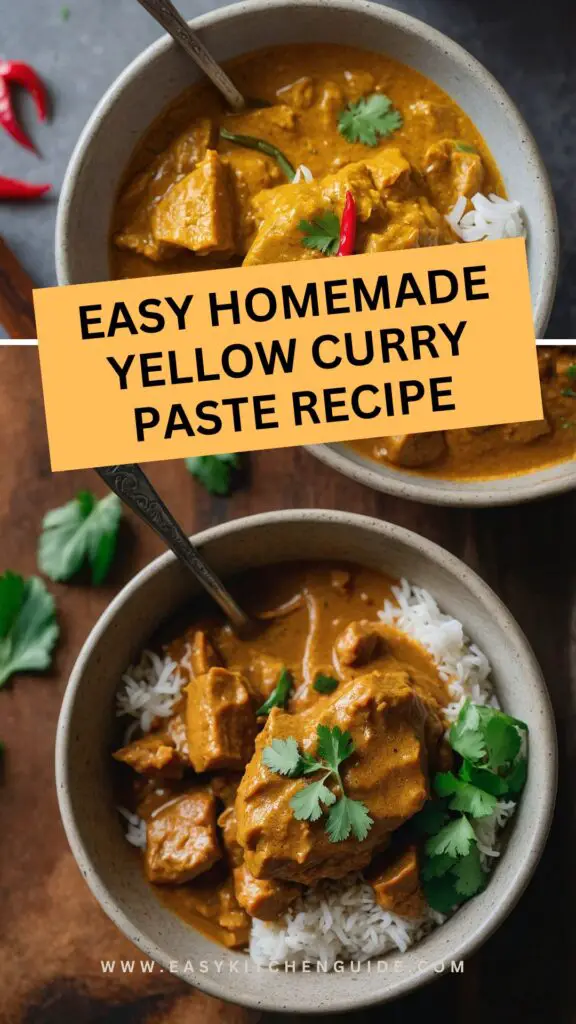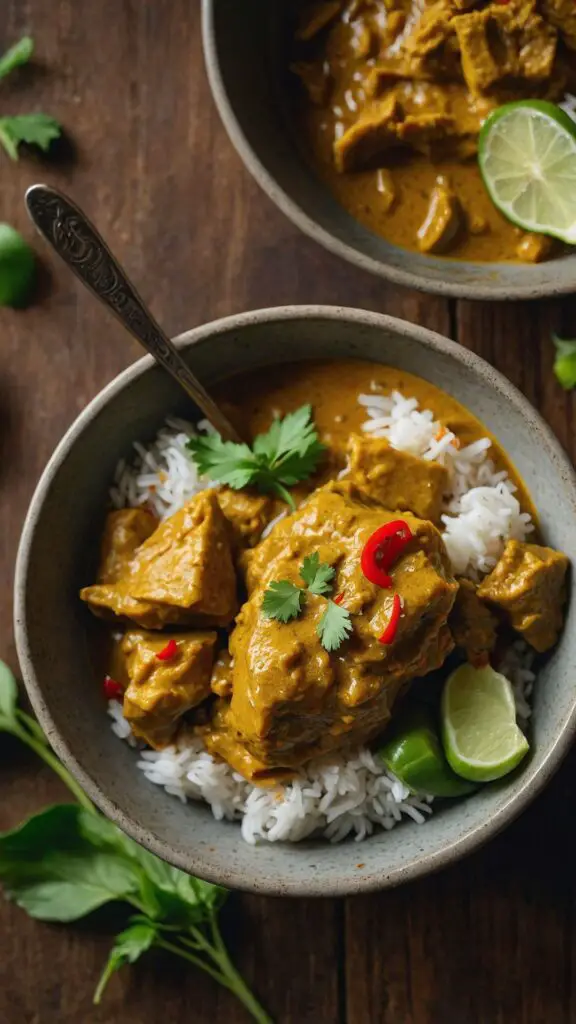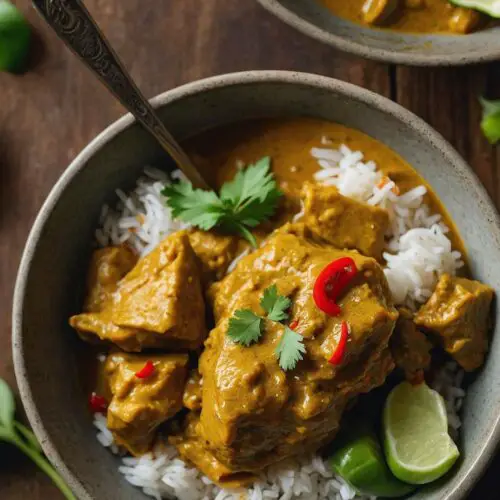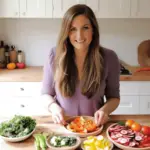Before we dive into this delightful appeal of homemade yellow curry paste, let’s take a moment to think about what dishes can elevate it. Imagine vibrant vegetables seeping in a rich, tangy flavor or luscious proteins soaking up the unique essence of spices. Something like chicken, whether grilled or sautéed, pairs divine. You could also opt for shrimp, which adds a touch of sweetness, lightening up the dish. Picture it: tender pieces swimming in that golden sauce. If you’re leaning toward a plant-based option, tofu, especially when crisped, absorbs flavors like a sponge. Veggies—roasted carrots, bell peppers, or spinach—add a splash of color. Lastly, consider coconut milk or a simple side of jasmine rice to balance spice with creaminess.
Now, let’s jump into the journey of crafting your own Easy Homemade Yellow Curry Paste.

Yellow curry holds a special place in my heart. Growing up in a diverse culinary household, spices were a daily feature. They brought heat, warmth, and depth to our meals. When I stumbled upon a yellow curry recipe about a decade ago, it instantly captured my taste buds and my enthusiasm for cooking. Fast forward to today, and I’ve perfected a simple, accessible yellow curry paste that anyone can whip up in their own kitchen.
This paste isn’t just about convenience; it’s about flavor and authenticity. Let me guide you on how to make it. We’ll explore the ingredients, the process, and how you can make this dish a staple in your home, regardless of your cooking experience.
What is Easy Homemade Yellow Curry Paste?
Easy Homemade Yellow Curry Paste is a vibrant blend of spices, aromatics, and flavorful ingredients that captures the essence of Southeast Asian cooking. Unlike the store-bought versions that might contain preservatives or flavors you can’t quite place, this homemade paste connects you to the roots of traditional recipes.
Imagine bright turmeric, zesty lime, and fragrant ginger working in harmony. Each ingredient complements the other, making it possible for the paste to shine in your dish, whether it guides a hearty soup or enhances a light stir-fry.
You will also like the following Sauces recipes!
- Whataburger Jalapeno Ranch Dip
- Copycat Homemade Honey Mustard Sauce
- How to make Easy Homemade Blueberry Sauce
Why This Recipe Works?
The beauty of this recipe lies in its simplicity and profound flavor. Fresh ingredients make all the difference. You can adjust levels of heat with the Thai bird’s eye chilies, ensuring enjoyment for everyone around the table. The recipe draws on some of the most essential ingredients in Thai cuisine, which work together to create depth, balance, and a little zing.
Moreover, making this paste at home allows you to control what goes in, so you can stay true to your preferences and dietary needs. Trust me; once you have a jar of homemade curry paste in the fridge, you’ll find endless opportunities to use it.
What You’ll Need to Make This Dish
Here’s your shopping list to create this fabulous curry paste:
- 6 tablespoons cold-pressed avocado oil
- 4 large shallot bulbs
- 3 tablespoons fresh lemongrass paste
- 4 whole large garlic bulbs
- 1/4 cup tightly packed fresh cilantro
- 5–20 dried whole Thai bird’s eye chili peppers
- 2–3 tablespoons mild yellow curry powder
- 6-inch piece of fresh ginger root
- 1 1/2 tablespoons sea salt
- 2 teaspoons toasted ground coriander seeds
- 2–3 tablespoons ground turmeric powder
- 1 tablespoon freshly squeezed lime juice

How to Make Easy Homemade Yellow Curry Paste?
This paste creation is straightforward. I’ll break it down into manageable steps for clarity. This way, you’ll feel like a culinary wizard in your kitchen, even on your busiest days.
Step 1: Prep Your Ingredients
Start by gathering all the ingredients on your kitchen counter. Wash your produce. Peel the garlic and ginger. Trim the shallots. Remember, cleanliness is vital! It sets a good foundation for your dish.
Step 2: Blend the Aromatics
In a food processor, combine the shallots, garlic, ginger, and lemongrass paste. Drizzle in the avocado oil. This step is where magic happens as the ingredients meld together into a flavorful base. Pulse until everything is finely chopped—the texture should be somewhat paste-like.
Step 3: Add Fresh Herbs
Toss in the fresh cilantro next. You’ll want to give this a few more pulses. Don’t be shy; blend it until the cilantro is finely incorporated. This not only enhances the flavor but also brings in that gorgeous green color.
Step 4: Spice it Up
Now, add the dried Thai bird’s eye chilies, yellow curry powder, ground turmeric, ground coriander, and sea salt to your mixture. This is where you can customize the heat level! Give the food processor another spin until the spices are well combined.
Step 5: Last Touches
Finally, finish by squeezing the fresh lime juice into the mix. Lime is our secret weapon, bringing freshness to the paste. Pulse once more until all is well incorporated into a beautiful spreadable paste.
Step 6: Taste and Adjust
Now, take a moment to taste your creation. Don’t be shy; adjust the salt if needed. Want more heat? Add another chili! This is your opportunity to let your preferences shine through.
Tips for Making the Best Yellow Curry Paste
- Use Fresh Ingredients: Fresh produce yields the best flavor. Nothing beats homegrown or recent market finds.
- Adjust Heat Levels: Know your audience! If you’re cooking for kids, dial down the chili. Conversely, add more if you’re like me and enjoy a kick.
- Blend in Batches: If you have a smaller food processor, blend in batches. This will help with achieving a smooth consistency.
- Experiment with Spices: Don’t hesitate to add spices you enjoy. Cumin or even a dash of curry leaves can add your personal twist.
- Make a Bigger Batch: This paste keeps well. Making extra lets you whip up curry on busy nights.
How to Store Leftovers?
You can store your leftover yellow curry paste in an airtight container. It will keep in the refrigerator for about one to two weeks. For longer storage, consider freezing it in ice cube trays. Once frozen, transfer the cubes to a freezer bag. They’ll be ready to toss into any dish whenever you need!
Nutrition Information
Easy Homemade Yellow Curry Paste Recipe Nutrition Facts
How Would I Recommend Serving Easy Homemade Yellow Curry Paste?
Here are some creative ways to use this delightful yellow curry paste:
- Chicken Yellow Curry: Prepare your favorite chicken parts. Cook them with coconut milk and add a few tablespoons of the curry paste. Serve over jasmine rice for a warm meal.
- Vegetable Stir-Fry: Toss your favorite vegetables in a pan with avocado oil, add the curry paste, and a splash of broth. This creates a quick, tasty dish.
- Curry Soup: Start with a broth base, add in the curry paste, and toss in noodles or vegetables. A bed of fresh cilantro tops it off.
- Tofu and Peppers: Stack some sizzling tofu with bell peppers, drizzle in your curry paste, and cook until all flavors blend. Served with rice, it’s a hit.

What Alternatives Can You Use for the Ingredients If Not Available?
Cooking can present challenges, especially when you can’t find an ingredient. Here are some alternatives:
- Shallots: Onion can work in a pinch, though it has a bolder flavor. Use less than the onion amount suggested.
- Lemongrass Paste: If unavailable, try lime zest mixed with a pinch of garlic for a fresh citrus boost.
- Thai Bird’s Eye Chilies: Red pepper flakes or jalapeños can replace these; however, adjust according to desired heat.
- Cilantro: If cilantro isn’t your thing, use parsley or basil. While flavors differ, they add a fresh element.

Easy Homemade Yellow Curry Paste
Equipment
Ingredients
- 6 tablespoons cold-pressed avocado oil
- 4 large shallot bulbs
- 3 tablespoons fresh lemongrass paste
- 4 whole large garlic bulbs
- 1/4 cup tightly packed fresh cilantro
- 5 –20 dried whole Thai bird’s eye chili peppers
- 2 –3 tablespoons mild yellow curry powder
- 6- inch piece of fresh ginger root
- 1 1/2 tablespoons sea salt
- 2 teaspoons toasted ground coriander seeds
- 2 –3 tablespoons ground turmeric powder
- 1 tablespoon freshly squeezed lime juice
Instructions
Step 1: Prep Your Ingredients
- Start by gathering all the ingredients on your kitchen counter. Wash your produce. Peel the garlic and ginger. Trim the shallots. Remember, cleanliness is vital! It sets a good foundation for your dish.
Step 2: Blend the Aromatics
- In a food processor, combine the shallots, garlic, ginger, and lemongrass paste. Drizzle in the avocado oil. This step is where magic happens as the ingredients meld together into a flavorful base. Pulse until everything is finely chopped—the texture should be somewhat paste-like.
Step 3: Add Fresh Herbs
- Toss in the fresh cilantro next. You’ll want to give this a few more pulses. Don’t be shy; blend it until the cilantro is finely incorporated. This not only enhances the flavor but also brings in that gorgeous green color.
Step 4: Spice it Up
- Now, add the dried Thai bird’s eye chilies, yellow curry powder, ground turmeric, ground coriander, and sea salt to your mixture. This is where you can customize the heat level! Give the food processor another spin until the spices are well combined.
Step 5: Last Touches
- Finally, finish by squeezing the fresh lime juice into the mix. Lime is our secret weapon, bringing freshness to the paste. Pulse once more until all is well incorporated into a beautiful spreadable paste.
Step 6: Taste and Adjust
- Now, take a moment to taste your creation. Don’t be shy; adjust the salt if needed. Want more heat? Add another chili! This is your opportunity to let your preferences shine through.
Notes
- Use Fresh Ingredients: Fresh produce yields the best flavor. Nothing beats homegrown or recent market finds.
- Adjust Heat Levels: Know your audience! If you’re cooking for kids, dial down the chili. Conversely, add more if you’re like me and enjoy a kick.
- Blend in Batches: If you have a smaller food processor, blend in batches. This will help with achieving a smooth consistency.
- Experiment with Spices: Don’t hesitate to add spices you enjoy. Cumin or even a dash of curry leaves can add your personal twist.
- Make a Bigger Batch: This paste keeps well. Making extra lets you whip up curry on busy nights.
Frequently Asked Questions
1. Can I make this curry paste without a food processor?
Absolutely! A mortar and pestle can produce a similar texture if you’re up for a little workout
2. How do I adjust the recipe for dietary restrictions?
This recipe is vegetarian and can be made gluten-free. Always check ingredient labels for any hidden gluten.
3. Can I use this curry paste for other cuisines?
Certainly! This paste adds a delicious twist to many dishes. It’s a fun addition to marinades and even salad dressings.
4. How do I know if I’ve made the paste correctly?
The paste should have a cohesive texture—spreadable but not too runny. The flavor should be aromatic and slightly spicy.
5. What happens if I can’t find fresh ginger?
You can use ground ginger as an alternative, but reduce the amount. The flavor differs but should still bring warmth.
6. Can I add protein to a yellow curry dish?
Of course! Feel free to add chicken, beef, shrimp, or even lentils for a wonderful taste and texture.
Conclusion
Crafting this Easy Homemade Yellow Curry Paste brings a wealth of flavor to your meal and allows for lots of customization. Engaging in this process opens up a doorway to explore different culinary avenues. Think of the joy in having home-prepared curry at your fingertips, ready to whisk you away with its tantalizing aroma and taste. It’s all about getting in the kitchen, embracing new flavors, and enjoying the delightful journey of cooking. Trust me when I say it’s not just about the food—it’s about the experience, the stories you create, and the smiles you’ll see at the table. Happy cooking!
You’ll also like these latest recipes!
- Homemade Cream Of Chicken Soup
- Healthy Chicken Gnocchi Soup Recipe
- 15 Minute Meal Prep Breakfast Sandwiches
My name is Lori Walker. I’m a registered dietitian, food blogger and food enthusiast. I share easy healthy, delicious recipes on my blog and review necessary kitchen items. The recipes I share take less… Read more
